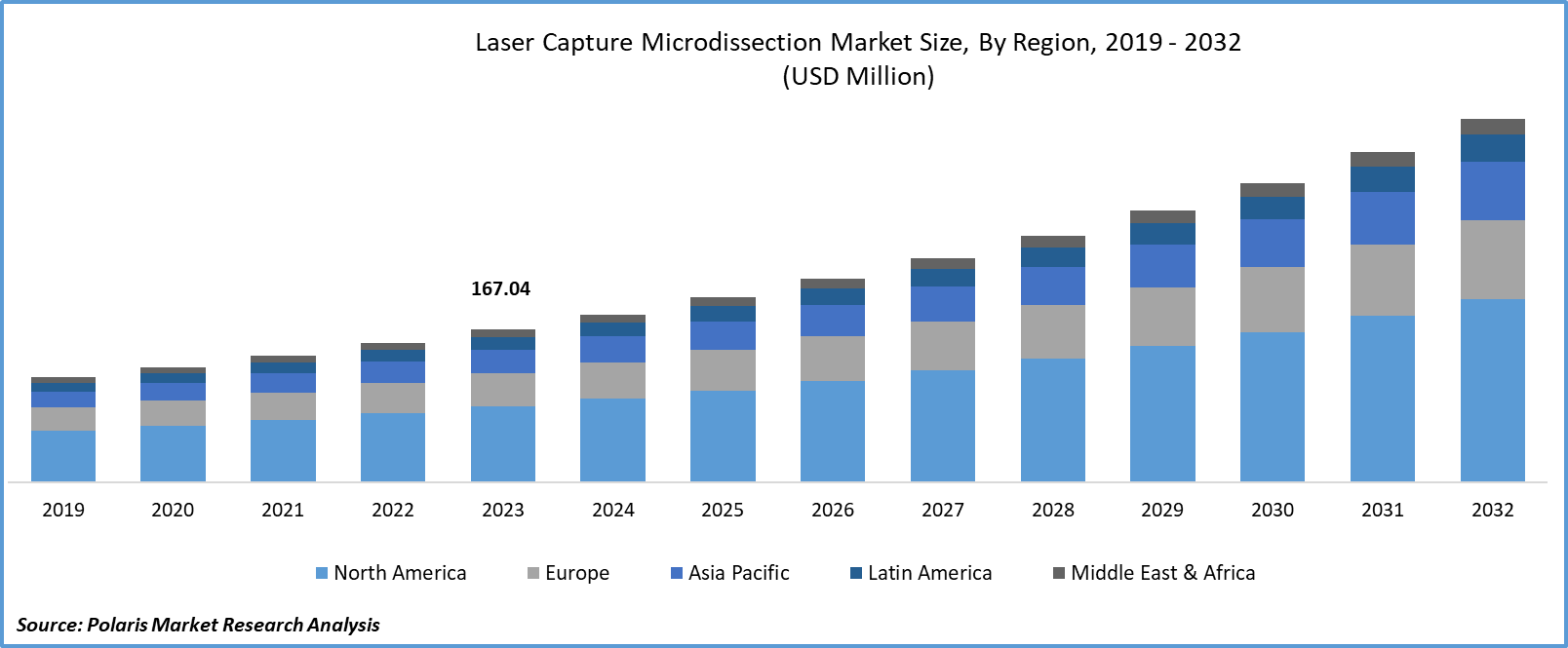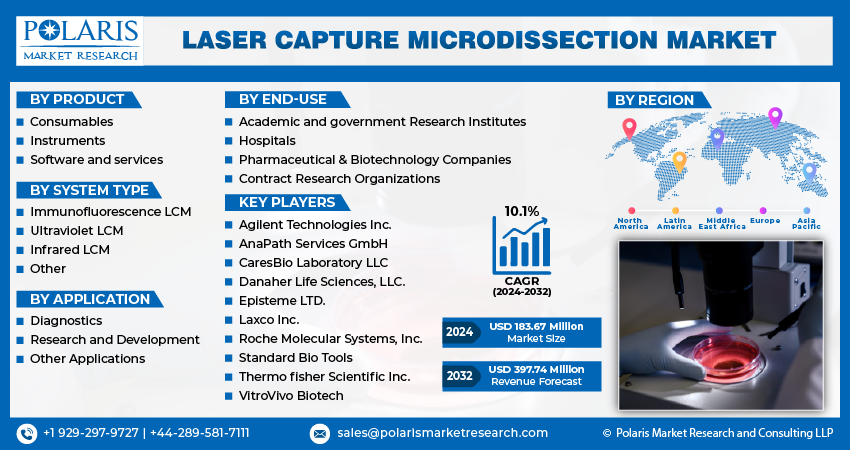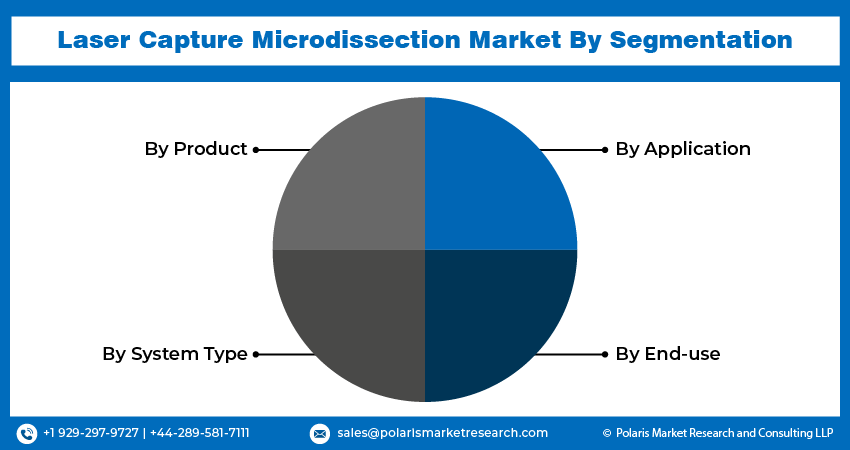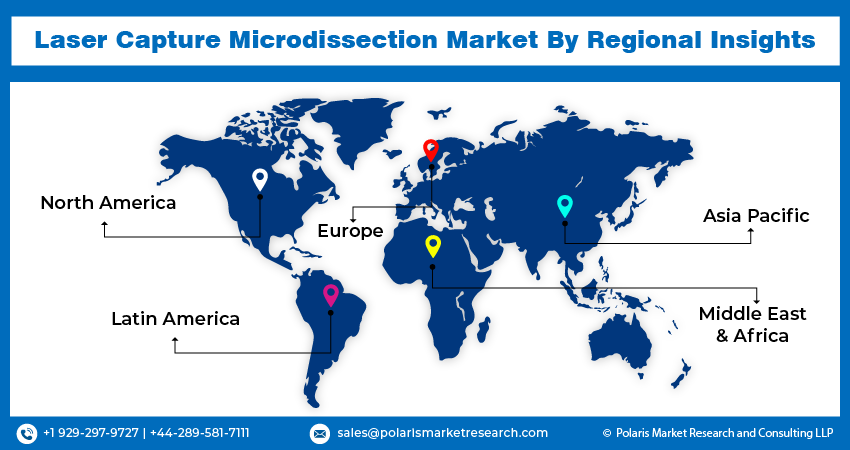
Laser Capture Microdissection Market Share, Size, Trends, Industry Analysis Report, By Product (Consumables, Instruments, Software And Services); By System Type; By Application; By End-Use; By Region.; Segment Forecast, 2024- 2032
- Published Date:Mar-2024
- Pages: 118
- Format: PDF
- Report ID: PM4766
- Base Year: 2023
- Historical Data: 2019-2022
Report Outlook
Global laser capture microdissection market size was valued at USD 167.04 million in 2023. The market is anticipated to grow from USD 183.67 million in 2024 to USD 397.74 million by 2032, exhibiting a CAGR of 10.1% during the forecast period.
Industry Trend
Laser Capture Micro-dissection (LCM) represents a cutting-edge sample preparation technology utilized for isolating precise single cells or entire tissue areas without contact or contamination. Primarily relying on direct microscopic visualization, LCM offers an efficient means of capturing pure cell populations essential for molecular studies. One of its key advantages lies in preserving the original morphology of the dissected tissue sample. By selectively dissecting unwanted cells and directly harvesting the cells of interest, LCM ensures the acquisition of pure enriched cells, thereby maintaining the authentic morphology of the dissected cell or tissue sample intact.
However, there's a prominent surge in the adoption of microdissection techniques for tissue sections and cytological preparations, driven by the increasing demand for precision in molecular studies and diagnostics. Additionally, the escalating research and development funding across various sectors, coupled with a rise in healthcare expenditure globally, further propel the laser capture microdissection market forward. These factors collectively contribute to the burgeoning demand for Laser Capture Microdissection technologies, as they play a pivotal role in advancing biomedical research, clinical diagnostics, and therapeutic development.

To Understand More About this Research: Request a Free Sample Report
The prominent companies in the market are continually innovating and launching Laser Capture Microdissection (LCM) systems to revolutionize processes by enhancing efficiency and accuracy. LCM systems utilize advanced laser technology to precisely isolate and capture specific cells or tissue regions from a sample for further analysis. By automating and optimizing this process, these systems enable researchers to obtain high-quality samples with minimal contamination and loss, ultimately improving the reliability and reproducibility of their results. This will result in a substantial rise in the growth of laser capture microdissection market share during the forecast period.
For instance, in November 2023, Laxco unveiled the Accuva Cellect Laser Capture Microdissection (LCM) System, engineered to facilitate the precise isolation and capture of individual cells. This system promises a significant advancement in research and analysis capabilities. Equipped with cutting-edge functionalities, it effortlessly slices through dense tissues and covers extensive areas in one swift pass, enhancing efficiency and accuracy.
Furthermore, the creation of "genetic fingerprints" for particular pathological lesions, particularly malignant neoplasms, the growth of the population, advancements in technology, the utilization of contamination-free techniques, and enhancements in healthcare infrastructure are all contributing positively to the Laser Capture Microdissection market. Moreover, the development of personalized treatments tailored to the molecular profile of tumors and the expansion of emerging markets are providing lucrative opportunities for players in the laser capture microdissection market.
Key Takeaway
- North America dominated the largest market and contributed to more than 38% of share in 2023.
- Asia Pacific market is expected to witness the fastest growing CAGR during the forecast period.
- By system type category, ultraviolet LCM segment accounted for the largest market share in 2023.
- By application category, the diagnostics segment is projected to grow at a high CAGR during the projected period.
What are the Market Drivers Driving the Demand for the Laser Capture Microdissection Market?
What are the Market Drivers Driving the Demand for the Laser Capture Microdissection Market?
The increasing adoption of microdissection in both tissue parts and cytological preparations reflects a notable trend in the field. This surge in usage is a key driver behind the growth observed in the Laser Capture Microdissection market. Factors such as rising healthcare expenditures and continuous technological advancements are pivotal contributors to this upward trajectory. Moreover, the substantial investment in research and development activities serves as a catalyst, propelling the expansion of the laser capture microdissection market share in the further.
The proliferation of hospitals, pharmaceutical companies, and research and development institutes adds to the momentum, creating a fertile ground for market growth. This growing infrastructure not only facilitates the adoption of laser capture microdissection but also fosters innovation and collaboration within the industry. Furthermore, the versatility of laser capture microdissection technology extends its applicability beyond traditional boundaries, finding utility in fields like forensic science and molecular biology. This broadening scope enhances its relevance and drives its adoption across various sectors.
The rising popularity of laser capture microdissection is reshaping the landscape of molecular studies, enabling precise analysis of cell populations such as carcinoma in situ or Hodgkin's disease malignant cells. By integrating with diplomatic analytical techniques like the polymerase chain reaction, laser capture microdissection provides insights that were previously unattainable through conventional methods. Hence, the laser capture microdissection market share is estimated to grow during the forecast period.
Which Factor is Restraining the Demand for Laser Capture Microdissection?
High Cost is Likely to Impede the Market Growth
The high cost associated with laser capture microdissection (LCM) technology encompasses various aspects, posing challenges for adoption in research laboratories and institutions with limited budgets. The initial investment in purchasing LCM instruments can be substantial. These instruments are sophisticated and specialized, designed to perform precise tissue microdissection under controlled conditions. The cost of acquiring such equipment can be significant, particularly for smaller research facilities or academic institutions operating on constrained budgets.
Moreover, the ongoing expenses for LCM extend beyond the initial purchase. Maintenance costs, including regular servicing and calibration of instruments, are essential to ensure optimal performance and accuracy. Additionally, the need for specialized consumables, such as laser-cutting membranes and sample collection devices, adds to the overall operating expenses. For research laboratories or institutions with limited financial resources, the high costs associated with LCM technology can be prohibitive. As a result, these entities may need help to invest in LCM instruments or may face challenges in sustaining ongoing operations due to budget constraints. This can lead to slower adoption rates of LCM technology in such settings, limiting its widespread use and impact in biomedical research and diagnostics.

Report Segmentation
The market is primarily segmented based on product, system type, application, end-use, and region.
|
By Product |
By System Type |
By Application |
By End-use |
By Region |
|
|
|
|
|
To Understand the Scope of this Report: Speak to Analyst
Category Wise Insights
By System Type Insights
Based on system type analysis, the market is segmented into immunofluorescence LCM, infrared LCM, ultraviolet LCM, and others. The ultraviolet LCM held the largest market share in 2023. Ultraviolet LCM offers enhanced precision and specificity in tissue microdissection compared to other methods. By using a focused UV laser beam to dissect target cells or tissue regions precisely, UV LCM allows researchers to isolate specific cell populations with high accuracy. This precision is crucial for applications such as molecular profiling of cancer cells or studying rare cell populations in complex tissues. The UV LCM technology has advanced significantly in recent years, with improvements in laser optics, sample handling systems, and software algorithms. These advancements have resulted in increased efficiency, reliability, and user-friendliness of UV LCM systems, making them more attractive to researchers and laboratories.
Additionally, UV LCM is compatible with a wide range of downstream molecular analysis techniques, including genomics, transcriptomics, and proteomics. This versatility allows researchers to perform comprehensive molecular profiling studies on micro-dissected samples, enabling deeper insights into biological processes and disease mechanisms.
By Application Insights
Based on application analysis, the market has been segmented into diagnostics, research and development, and other applications. The diagnostics segment is expected to witness the fastest-growing CAGR during the forecast period. There is a growing trend towards personalized or precision medicine, which involves tailoring medical treatment to the individual characteristics of each patient. Laser capture microdissection plays a crucial role in this area by enabling the isolation and analysis of specific cell populations from patient samples. As precision medicine continues to gain traction, the demand for LCM technologies in diagnostic applications is expected to rise significantly. LCM facilitates the precise isolation of cancer cells or tumor microenvironments from tissue samples, allowing for in-depth molecular analysis. This is particularly relevant in cancer diagnostics and biomarker discovery, where identifying specific genetic or protein markers associated with different types of cancer can aid in early detection, prognosis, and treatment selection.

Regional Insights
North America
North America region accounted for the largest market share in 2023. North America boasts a highly developed healthcare infrastructure with advanced research facilities, academic institutions, and well-established pharmaceutical and biotechnology industries. These factors contribute to a robust demand for cutting-edge technologies like LCM, driving market growth in the region. The region is a global leader in biomedical research and innovation, with substantial investments in R&D across various sectors. Academic and research institutions in
North America conducts extensive studies in fields such as cancer biology, neuroscience, and molecular diagnostics, all of which rely on LCM for precise tissue analysis. The presence of major research centers and collaborations with industry players further stimulate the adoption of LCM technologies, fueling market growth. Moreover, North America is at the forefront of technological innovation, including advancements in LCM systems and associated software. Hence, the North American region held the largest laser capture microdissection market share in 2023 and is expected to dominate the market in the forecast period.
Asia Pacific
Asia Pacific is expected to grow growth at the fastest CAGR during the forecast period. The Asia-Pacific region is witnessing significant growth in healthcare infrastructure, with countries investing heavily in expanding and modernizing healthcare facilities. This includes the establishment of new hospitals, research centers, and diagnostic laboratories, creating a conducive environment for the adoption of advanced technologies like Laser Capture Microdissection (LCM). Many countries in Asia-Pacific are increasing their investments in R&D, particularly in the fields of biotechnology, pharmaceuticals, and life sciences. Academic institutions, government agencies, and private companies are conducting extensive research in areas such as cancer biology, infectious diseases, and personalized medicine, driving the demand for innovative technologies like LCM. LCM technologies play a crucial role in understanding the molecular mechanisms of these diseases, identifying biomarkers, and developing targeted therapies, driving their adoption in diagnostic and research applications.

Competitive Landscape
The laser capture microdissection market is characterized by fragmentation, with competition arising from numerous players. Key service providers in this sector are consistently improving their technologies to stay forward, concentrating on reliability, efficiency, and safety. These entities aim for a strong market presence by prioritizing strategic partnerships, continual product improvements, and collaborative efforts to outperform competitors in the industry.
Some of the major players operating in the global market include:
- Agilent Technologies Inc.
- AnaPath Services GmbH
- CaresBio Laboratory LLC
- Danaher Life Sciences, LLC.
- Episteme LTD.
- Laxco Inc.
- Roche Molecular Systems, Inc.
- Standard Bio Tools
- Thermo fisher Scientific Inc.
- VitroVivo Biotech
Recent Developments
- In March 2022, Fluidigm Corporation, a biotechnology tools provider dedicated to enhancing life through comprehensive health insights, has unveiled its latest offering: the AccuLift Laser Capture Microdissection System. Tailored for clinical pathology and translational research, this new AccuLift product line facilitates the precise and efficient capture of individual cells or broader tissue regions, facilitating the analysis of RNA, DNA, and protein biomarkers.
Report Coverage
The laser capture microdissection market report emphasizes on key regions across the globe to provide better understanding of the product to the users. Also, the report provides market insights into recent developments, trends and analyzes the technologies that are gaining traction around the globe. Furthermore, the report covers in-depth qualitative analysis pertaining to various paradigm shifts associated with the transformation of these solutions.
The report provides detailed analysis of the market while focusing on various key aspects such as competitive analysis, product, system type, application, end-use, and their futuristic growth opportunities.
Laser Capture Microdissection Market Report Scope
|
Report Attributes |
Details |
|
Market size value in 2024 |
USD 183.67 million |
|
Revenue forecast in 2032 |
USD 397.74 million |
|
CAGR |
10.1% from 2024 – 2032 |
|
Base year |
2023 |
|
Historical data |
2019 – 2022 |
|
Forecast period |
2024 – 2032 |
|
Quantitative units |
Revenue in USD million and CAGR from 2024 to 2032 |
|
Segments covered |
By Product, By System Type, By Application, By End-Use And By Region |
|
Regional scope |
North America, Europe, Asia Pacific, Latin America, Middle East & Africa |
|
Customization |
Report customization as per your requirements with respect to countries, region, and segmentation. |
FAQ's
The Laser Capture Microdissection Market report covering key segments are product, system type, application, end-use and region.
The global laser capture microdissection market size is expected to reach USD 397.74 million by 2032
Laser capture microdissection market exhibiting a CAGR of 10.1% during the forecast period.
Asia Pacific is leading the global market
key driving factors in Laser Capture Microdissection Market are increasing adoption of microdissection
